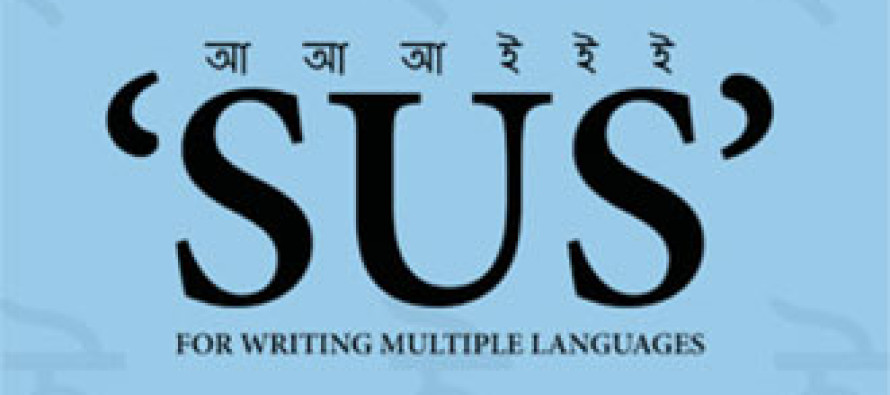Bangladeshi Scholars Invented Unified Scripts to Write All the Languages of the World

Two Bangladeshi scholars, Prof. Bijon B Sarma and Dr Mira R Sarma-Parai, have jointly invented Sarma’s Unified Script (SUS) – the latest ‘unified script’- which is capable of writing all the languages of the world. None of the ‘unified scripts’ invented prior to the invention of SUS could satisfy the multifarious needs of various languages. SUS is so simple that the new learners may need 1-2 weeks to learn it.
From time immemorial, unified script is the dream of all experts. Kublai Khan, the king of Tibet, initiated one such endeavor in 1260 AD. The Lama, who was assigned to this task, invented the script ‘Phags Pa’ in 1269. Vitaly Vetash, an artist and a linguist from Russia, worked from 1977 to 1999 and invented ‘Interbet’. Unfortunately, none of these inventions could satisfy the needs of various languages.
Human’s profound love is generally associated with their mother language. Whatever difficult or bad-sounding their mother-language might be, they cannot tolerate its alteration. In 1952 in East Pakistan, the common people sacrificed their lives for the cause of their mother language – Bangla. In any language, the sounds or the ‘speaking language’ is most important, where the scripts act like ‘carry-bags’ and serve the purpose of transportation. The illiterate people satisfactorily use language without knowing anything of scripts. So, there should not be any complain if the problematic script of one language is replaced by a better one. The change however, should not change the verbal language including sound and general characteristics. In fact many prominent languages have changed their scripts for genuine reasons.
Since SUS changes only the written form and not the sounds, it is capable of saving languages from sound distortions. Writing in SUS scripts is easy and simple – it uses only a few straight lines running in cardinal directions and not in circular, angular, or retracing lines. The number of strokes required for writing languages using letters like English, is only 4. Languages using vowel signs like Bengali, Arabic, etc, require about 20 strokes. SUS also indicates how the languages using vowel-signs can enjoy the advantage of simple and quick writing and to eliminate spelling mistakes. Since SUS is written by strokes, it can be written by using fewer keys assigned for the strokes. SUS scripts are self-generating, which means each script can be created from the previous one by following logical principles. Because of the use of only straight lines, there is little scope for ‘bad hand-writing’ and problem in translating. The fewer the number of keyboards may be helpful for the manufacturers of mobile phones and keyboards. It will also be useful for the blind and handicapped people.
The basic principle of SUS has been explained in the book titled ‘SUS for writing multiple languages’ (ISBN: 978-1-4269-0939-9) published by Trafford Publishing, Canada and USA (http://www.trafford.com/Bookstore/BookDetail.aspx?BookId=SKU-000130700). Also Lambert Academic Publishing (LAP), Germany is publishing ‘SUS’, the latest ‘unified script’ in August, 2010.
Prof. Bijon B Sarma also devised ‘low-cost roof insulation’ by using burnt-pots and the system is now used in Bangladesh and India. He wrote a number of text books for the students of Architecture.

Currently, Prof. Sarma is the Dean of the Faculty of Architecture and Planning and Head of the Department of Architecture, Ahsanullah University of Science and Technology (AUST) in Bangladesh. Prof. Sarma graduated as an Architect with Gold Medal (M.Arch.) from the Bangladesh University of Engineering and Technology (BUET), and worked with the Khulna University (991- 2010) and the Government of Nigeria (1982-1988). He is the son of late Dr. Gopi Ballav Sarma and Laxmi Rani Sarma of Bhola district in Bangladesh.

Doctor Mira R Sarma-Parai who is the sister of Prof. Sarma, is currently working as a Pathologist in Red Deer, Alberta, Canada. She writes with nickname ‘MaryAnn’. She is a co-author of two novels – Journey to the East [(ISBN 1-55212-755-9) (www.trafford.com/robots/01-0155.html)] and The Drum-lime Migration [(ISBN 1-55369-266-7)- www.trafford.com/robots/02-0079.html] with her brother Prof. Sarma. Both novels have received acclaim from readers across the world.


